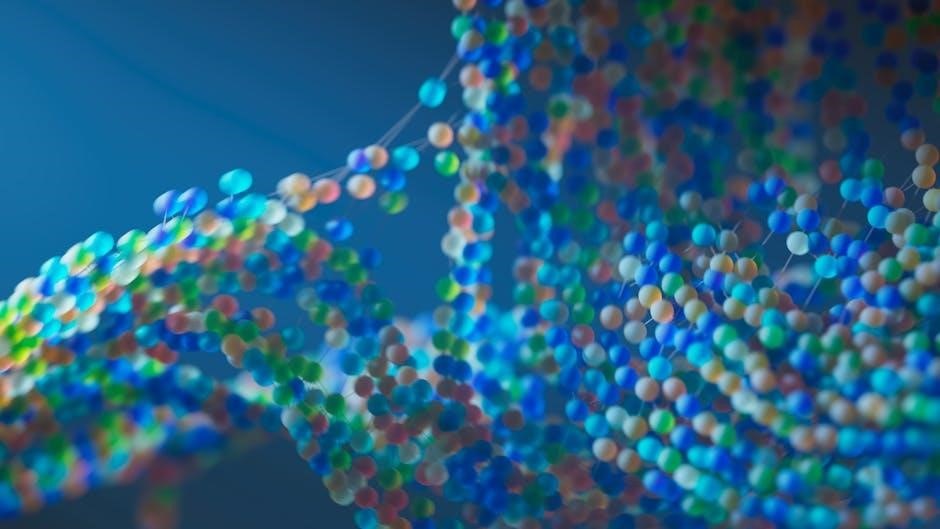Organic chemistry studies carbon compounds, forming the basis of life and synthetic materials. It explores structures, properties, and reactions, underpinning fields like medicine, agriculture, and materials science. The 9th edition enhances understanding of fundamental principles, offering updated tools for modern learning and application in various scientific disciplines.
1.1. Definition and Scope of Organic Chemistry
Organic chemistry is the scientific study of carbon-based compounds, focusing on their structures, properties, and reactions. It encompasses the chemistry of life, including biomolecules like carbohydrates, proteins, and DNA, as well as synthetic polymers and pharmaceuticals. The scope of organic chemistry is vast, extending from the molecular basis of life to the development of materials, fuels, and medications. Understanding organic chemistry is essential for advancing fields such as medicine, agriculture, and environmental science, making it a cornerstone of modern scientific inquiry and innovation.
1.2. Importance of Organic Chemistry in Modern Science
Organic chemistry plays a pivotal role in advancing modern science, driving innovations in medicine, agriculture, and materials science. It underpins the development of pharmaceuticals, agrochemicals, and polymers, addressing global challenges like disease, food security, and sustainability. The principles of organic chemistry are essential for understanding biological processes and designing new compounds. Its applications span drug discovery, environmental solutions, and advanced materials, making it a cornerstone of scientific progress. The 9th edition of Wade’s text equips students with the knowledge to contribute to these fields, emphasizing problem-solving and critical thinking.

Overview of the 9th Edition of Wade’s Organic Chemistry
The 9th edition, authored by Leroy G. Wade Jr. and Jan William Simek, offers expanded coverage of acids, bases, and reaction mechanisms, enhancing modern pedagogy.
2.1. Authors and Their Contributions
Leroy G. Wade Jr. and Jan William Simek are renowned educators in organic chemistry. Wade, from Whitman College, brings extensive teaching experience, while Simek, from Cal Poly, contributes practical industry insights. Their collaborative effort in the 9th edition ensures a balanced approach, blending theoretical foundations with real-world applications. Their contributions include clarified explanations, updated examples, and enhanced problem-solving strategies, making complex concepts accessible to students. Their work has been praised for fostering a deeper understanding of organic principles.
2.2. Key Features of the 9th Edition
The 9th edition of Wade’s Organic Chemistry offers enhanced pedagogical tools, including expanded coverage of acids and bases, and a clearer separation of substitution and elimination reactions. It integrates visual and textual content to aid comprehension, with updated spectroscopy sections and modern approaches to teaching. Digital resources like OWLv2 provide interactive learning, while video lessons and practice problems support student success. These features ensure a comprehensive and engaging learning experience tailored for chemistry and biochemistry majors;
2.3. Target Audience: Chemistry and Biochemistry Majors
The 9th edition of Wade’s Organic Chemistry is designed primarily for undergraduate chemistry and biochemistry majors. It provides a comprehensive foundation in organic principles, with clear explanations and practical applications. The textbook supports students in developing problem-solving skills and chemical reasoning, essential for advanced studies and careers in science. Enhanced digital tools, such as OWLv2, cater to diverse learning styles, while video lessons and practice problems reinforce key concepts. This edition is particularly suited for students seeking a modern, engaging approach to mastering organic chemistry.

Structure and Organization of the Book
The 9th edition is organized logically, with chapters progressing from fundamental concepts to complex topics. It integrates visual aids, practice problems, and digital tools for enhanced learning.
3.1. Chapter Breakdown and Content Coverage
The 9th edition is divided into comprehensive chapters, starting with foundational concepts like bonding and molecular structure. Subsequent chapters delve into functional groups, reaction mechanisms, and spectroscopy, providing detailed explanations and examples. The book progresses logically, building on earlier topics to explore complex reactions and modern applications. Expanded sections on acids, bases, and substitution/elimination reactions offer deeper insights. Each chapter includes practice problems and digital tools, ensuring a well-rounded understanding of organic chemistry principles and their practical applications.
3.2. Pedagogical Tools and Learning Aids
The 9th edition incorporates a range of pedagogical tools to enhance learning. A solutions manual provides detailed answers to practice problems, while digital platforms like OWLv2 offer interactive exercises and video lessons. Each chapter includes step-by-step problem-solving guides, helping students master complex reactions and mechanisms. Additionally, interactive content and visual aids, such as 3D molecular models, cater to diverse learning styles. These tools, combined with real-world applications, ensure a comprehensive and engaging learning experience for students and instructors alike.
3.3. Integration of Visual and Textual Content
The 9th edition seamlessly integrates visual and textual content to enhance understanding. Detailed illustrations, such as reaction mechanisms and molecular structures, are paired with clear explanations. Digital tools, including 3D molecular models, allow students to visualize complex concepts interactively. Video lessons and animations further complement the text, making abstract ideas more tangible. This integrated approach ensures that students can grasp both the theoretical and practical aspects of organic chemistry, fostering a deeper appreciation of the subject and its applications. The combination of visual and textual elements caters to diverse learning styles, enriching the educational experience.

Major Topics and Concepts Covered
Key topics include molecular structure, functional groups, reaction mechanisms, and spectroscopy. The text delves into bonding, acids/bases, substitution/elimination reactions, and modern approaches to teaching organic chemistry.
4.1. Bonding and Molecular Structure

Organic chemistry fundamentally explores bonding and molecular structure, focusing on how atoms share electrons to form molecules. The 9th edition delves into atomic orbitals, hybridization, and molecular geometry, providing a clear understanding of how bonding dictates molecular properties. Key concepts include sigma and pi bonds, resonance, and delocalized electrons. The text emphasizes the relationship between structure and reactivity, enabling students to predict and explain molecular behavior. Detailed illustrations and examples help visualize complex bonding scenarios, making abstract concepts accessible for learners at all levels.
4.2. Functional Groups and Their Reactions
Functional groups are specific clusters of atoms within molecules that determine their chemical reactivity. The 9th edition provides a comprehensive exploration of these groups, including alkanes, alkenes, alkynes, and their derivatives. It details how functional groups influence reaction mechanisms, such as substitution, elimination, and addition, while emphasizing the role of electronegativity and bond polarity. The text also covers the synthesis and transformation of functional groups, highlighting their importance in organic synthesis. This section equips students with the ability to predict and analyze reactions, forming a foundation for advanced studies in organic chemistry.
4.3. Reaction Mechanisms and Stereochemistry
Reaction mechanisms and stereochemistry are central to understanding how organic compounds react and form products. The 9th edition elaborates on the principles of reaction pathways, including nucleophilic substitution, elimination, and addition reactions. It emphasizes the importance of stereochemical outcomes, such as cis-trans isomerism and enantiomer formation. Detailed mechanisms and visual aids help students grasp how reactants transform into products. This section also explores the role of stereochemistry in controlling reaction outcomes, providing a strong foundation for advanced organic synthesis and molecular design.
4.4. Spectroscopy and Structural Analysis
Spectroscopy and structural analysis are essential tools in organic chemistry for identifying and characterizing compounds. The 9th edition provides comprehensive coverage of techniques such as infrared (IR), nuclear magnetic resonance (NMR), and mass spectrometry (MS). These methods enable chemists to determine molecular structures by analyzing absorption patterns, chemical shifts, and fragmentation data. The text integrates practical examples and problem sets to help students master spectral interpretation, a critical skill for understanding reaction outcomes and molecular identification in both academic and industrial settings.

Updates in the 9th Edition
The 9th edition features expanded coverage of acids and bases, enhanced discussion of substitution and elimination reactions, and modern teaching approaches for better student engagement and understanding.
5.1. Expanded Coverage of Acids and Bases
The 9th edition of Wade’s Organic Chemistry includes a comprehensive expansion of its discussion on acids and bases, providing deeper insights into their roles in organic reactions. This section introduces new concepts and frameworks for understanding acidity and basicity, with a focus on how these properties influence reaction mechanisms. Students gain a stronger foundation for analyzing and predicting the behavior of organic compounds in various chemical environments. This enhanced coverage ensures a more thorough understanding of these fundamental principles, essential for advanced studies in organic chemistry.
5.2. Enhanced Discussion of Substitution and Elimination Reactions
The 9th edition of Wade’s Organic Chemistry features an enhanced exploration of substitution and elimination reactions, providing students with a clearer understanding of these fundamental processes. The text delves into the mechanisms, stereochemistry, and reaction conditions that govern these transformations. New examples and illustrations help clarify key concepts, while expanded problem sets allow for better practice and application. This thorough approach ensures that students can master the nuances of these reactions, which are critical in organic synthesis and chemical analysis.
5.3. Modern Approaches to Teaching Organic Chemistry
The 9th edition incorporates innovative teaching methods to engage students and enhance understanding. It integrates active learning strategies, interactive digital tools, and real-world applications to make complex concepts more accessible. The text emphasizes problem-solving and critical thinking through updated examples and visual aids. Additionally, the inclusion of online resources, such as OWLv2, provides students with personalized learning experiences. This modern approach ensures that students develop a deep understanding of organic chemistry while fostering practical skills for future scientific endeavors.

Study Resources and Supplements
The 9th edition offers a Solutions Manual with detailed explanations, practice problems, and digital tools like OWLv2 for interactive learning. Video lessons enhance conceptual understanding and problem-solving skills.
6.1. Solutions Manual and Practice Problems
The Solutions Manual provides comprehensive answers to textbook problems, ensuring clarity and understanding. Practice problems cover various topics, from basic concepts to advanced reactions, helping students master organic chemistry. The manual includes detailed explanations, alternative approaches, and common pitfalls to avoid. These resources are designed to complement the textbook, offering students a thorough review of key concepts and skills needed for success in the course.
6.2. Digital Learning Tools and OWLv2 Access
Wade’s 9th Edition offers enhanced digital learning tools, including OWLv2 access, to support student success. OWLv2 provides interactive simulations, video lessons, and practice problems with immediate feedback. Students can track their progress and identify areas for improvement. The platform integrates with textbook content, offering a personalized and adaptive learning experience. Digital tools include interactive visualizations, quizzes, and homework assignments, making complex organic chemistry concepts more engaging and accessible for modern learners.
6.3. Video Lessons and Interactive Content
The 9th edition of Wade’s Organic Chemistry includes video lessons and interactive content to enhance learning. These resources provide visual explanations of complex reactions and mechanisms, helping students grasp difficult concepts. Interactive simulations allow learners to explore 3D molecular structures and practice problem-solving skills. The video lessons cover key topics, such as reaction mechanisms and spectroscopy, while interactive exercises offer hands-on practice. These tools are designed to supplement textbook material, making learning engaging and effective for both visual and kinesthetic learners.

Availability and Access
The 9th edition is available in hardcover, eTextbook, and rental formats. Subscription-based study packs offer digital access, enhancing flexibility for learners worldwide.
7.1. Purchase Options: Hardcover, eTextbook, and Rental
The 9th edition of Wade’s Organic Chemistry is available in hardcover, eTextbook, and rental formats, offering flexibility for students. The hardcover provides a traditional learning experience, while the eTextbook allows digital access for convenience. Rental options reduce costs for short-term use. Additionally, the book can be purchased as part of subscription-based study packs, which include digital learning tools like OWLv2. These options cater to diverse student preferences and budgets, ensuring accessibility to this comprehensive resource for organic chemistry education.
7.2. Free Download Options and PDF Availability
The 9th edition of Wade’s Organic Chemistry can be accessed as a free PDF download through various online platforms, such as chemistry;com.pk, offering convenience for students and researchers. While the official publisher, Pearson, does not provide free downloads, third-party websites offer the book in PDF format. Users can search using the ISBN or book title to locate these resources; However, downloading from unofficial sources may raise copyright concerns. This option remains popular due to its accessibility and affordability for those seeking a digital copy of the textbook.
7.3. Subscription-Based Study Packs
Subscription-based study packs for the 9th edition of Wade’s Organic Chemistry offer flexible access to digital resources. These packs typically include the eTextbook, OWLv2 access, video lessons, and practice problems. Subscriptions are available on a monthly basis, with options like the Study Prep Pack priced at $15.99/month. This model provides affordability and convenience for students seeking comprehensive study materials without purchasing a hardcover or eTextbook outright. The subscription approach aligns with modern learning preferences, offering access to updated content and interactive tools to enhance understanding and retention of organic chemistry concepts.

Reviews and Ratings
The 9th edition of Wade’s Organic Chemistry has received positive reviews for its clear explanations and organized structure, praised by both students and instructors alike.
8.1. Student Feedback and Recommendations
Students praise the 9th edition of Wade’s Organic Chemistry for its clarity and organization. Many appreciate the expanded coverage of key topics like acids and bases, finding it helpful for problem-solving. The integration of visual aids and digital tools, such as OWLv2, enhances their learning experience. Instructors also commend the textbook for its comprehensive approach, making it a preferred choice for chemistry and biochemistry majors. Overall, the edition is highly recommended for its balanced blend of theoretical and practical content, supporting academic success in organic chemistry.
8.2. Instructor and Expert Reviews
Instructors and experts highly praise the 9th edition of Wade’s Organic Chemistry for its refined pedagogy and comprehensive coverage. The expanded discussions on acids, bases, and reaction mechanisms are particularly commended for enhancing conceptual understanding. The integration of digital tools, such as OWLv2, is noted as a significant advancement in engaging students. Experts appreciate the balanced approach between theoretical foundations and practical applications, making it a valuable resource for both teaching and research. The textbook is widely regarded as a cornerstone for organic chemistry education, aligning with modern pedagogical standards and student needs.
8.3. Comparison with Previous Editions
The 9th edition of Wade’s Organic Chemistry builds on earlier versions with significant improvements. It features expanded coverage of acids and bases, enhanced discussion of substitution and elimination reactions, and refined pedagogical tools. Compared to previous editions, the 9th edition offers clearer explanations, improved visual aids, and better integration of digital resources. The updated content reflects modern teaching methods and student needs, making it more accessible and effective for learning. These enhancements solidify its reputation as a leading textbook in organic chemistry education.

The Role of Organic Chemistry in Education
Organic chemistry is foundational for chemistry and biochemistry majors, providing essential skills in molecular analysis and synthesis. The 9th edition enhances learning through modern pedagogy and tools.
9.1. Curriculum Integration in Chemistry Programs
Organic chemistry is a cornerstone of undergraduate chemistry programs, providing foundational knowledge of molecular structures, reactions, and synthesis. The 9th edition of Wade’s Organic Chemistry is widely integrated into curricula, offering a comprehensive framework for understanding core principles. Its structured approach aligns with course objectives, enabling students to build a strong conceptual base. The textbook supports lab and lecture components, fostering practical and theoretical skills essential for chemistry and biochemistry majors. This integration ensures students are well-prepared for advanced studies and professional applications in science.
9.2. Preparation for Advanced Studies and Careers
Organic chemistry is pivotal for students pursuing advanced degrees or careers in chemistry, biochemistry, and related fields. The 9th edition of Wade’s Organic Chemistry equips learners with a deep understanding of molecular structures, reaction mechanisms, and analytical techniques. It enhances problem-solving and critical-thinking skills, essential for research and professional environments. The textbook’s comprehensive coverage prepares students for graduate studies, medical school, and industries like pharmaceuticals and biotechnology. Its emphasis on practical applications ensures readiness for real-world challenges, making it an indispensable resource for future scientists and professionals.
9.3. Interdisciplinary Applications in Biology and Medicine
Organic chemistry is integral to understanding biological processes and advancing medical science. The 9th edition of Wade’s Organic Chemistry highlights connections between molecular structures and their biological functions, such as drug design, metabolism, and enzyme mechanisms. It bridges chemistry with biology, enabling students to grasp how organic compounds interact in living systems. This knowledge is crucial for fields like biochemistry, pharmacology, and biotechnology, where understanding chemical reactions drives innovations in healthcare and drug development. The textbook’s insights prepare learners to contribute to cutting-edge research and medical advancements.
The 9th edition of Wade’s Organic Chemistry is a comprehensive resource, effectively guiding students to build a strong foundation in organic chemistry. Its modern approach ensures relevance for future studies and applications in various scientific fields.
10.1. Final Thoughts on the 9th Edition
The 9th edition of Wade’s Organic Chemistry is a comprehensive and well-structured resource that effectively addresses the needs of modern students. With its enhanced pedagogical features, expanded coverage of key topics, and integration of visual and textual content, it provides a robust foundation for understanding organic chemistry. The edition’s focus on problem-solving and critical thinking makes it an invaluable tool for both undergraduate students and professionals seeking to refine their knowledge. Its accessibility and clarity ensure that learners at all levels can engage with the material effectively, making it a standout resource in the field.
10.2. Future Prospects for Organic Chemistry Education
Organic chemistry education is poised for innovation, with a focus on integrating advanced digital tools and interactive learning platforms. The 9th edition of Wade’s text exemplifies this trend, emphasizing problem-solving and critical thinking. Future editions may incorporate virtual labs, AI-driven study aids, and real-world applications to enhance engagement. Expanding interdisciplinary connections, such as with biology and materials science, will further enrich the field. By leveraging technology and modern pedagogical approaches, organic chemistry education will continue to evolve, preparing students for emerging challenges in science and industry while maintaining foundational scientific rigor.
